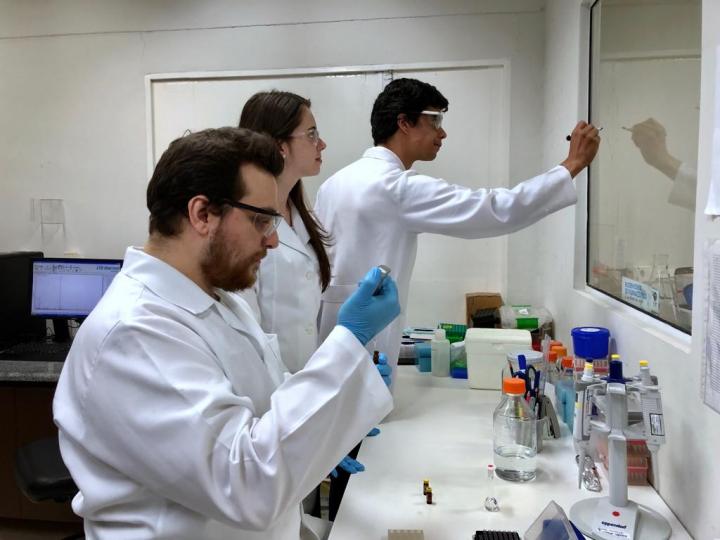Experiments performed by Brazilian scientists showed that Zika virus inhibits tumor cell proliferation even when inactivated by high temperature; the study was supported by FAPESP and published in Scientific Reports

Credit: Flávia Luísa Dias Aldibert
The study was led by Rodrigo Ramos Catharino, a professor in UNICAMP’s School of Pharmaceutical Sciences.
In experiments with a human prostate adenocarcinoma cell line (PC-3), the scientists found that Zika inhibits tumor cell proliferation even when inactivated by high temperature. Results of their research, which is supported by São Paulo Research Foundation – FAPESP, have been published) in Scientific Reports.
“The next step in the investigation involves tests in animals. If the results are positive, we plan to look for companies with which to partner on clinical trials,” said Catharino, who also works as principal investigator for UNICAMP’s Innovare Biomarker Laboratory.
The research project coordinated by Catharino began in 2015, when the link between the Zika epidemic and the rising number of microcephaly cases in Northeast Brazil was discovered. After studies confirmed that Zika can infect and destroy neural progenitor cells, which are precursors of the various types of brain cells in the fetus, Catharino decided to determine the effects of the virus on glioblastoma cells. Glioblastoma is the most common and aggressive type of central nervous system cancer in adults (read more at agencia.fapesp.br/27166).
The positive in vitro results obtained by the UNICAMP group were confirmed in an animal model by scientists at the Human Genome and Stem Cell Research Center (HUG-CELL), a Research, Innovation and Dissemination Center (RIDC) supported by FAPESP and hosted by the University of São Paulo – USP (read more at agencia.fapesp.br/27677).
“Because it’s been confirmed that Zika is sexually transmitted and prefers infecting reproductive cells, we now want to test its effectiveness against prostate cancer,” Innovare laboratory team member Jeany Delafiori told Agência FAPESP. Catharino is Delafiori’s PhD thesis advisor.
The research is also supported by the Obesity and Comorbidities Research Center (OCRC), another of FAPESP’s RIDCs, in this case hosted by UNICAMP.
Persistent inflammation
In another recent study published in Scientific Reports, Catharino and his group reported the identification of markers of neurological inflammation as many as two years after birth in the saliva of babies born with microcephaly to mothers diagnosed with Zika during pregnancy.
“This shows that Zika induces inflammation that lasts a long time, persisting even after the virus has been completely eliminated from the organism,” Catharino said. “The ‘wild’ version of the virus [without inactivation] could therefore have undesirable effects and won’t be usable therapeutically.”
The researchers therefore decided to determine whether Zika retains the capacity to destroy tumor cells after inactivation. The experiments were performed with a viral lineage obtained from samples isolated from a patient infected in the northeastern state of Ceará in 2015. After cultivation in the laboratory, the virus was fused with a nanoparticle and heated to 56 °C for one hour to suppress its infection potential.
The next step was to expose cultured PC-3 (prostate cancer) cells to the inactivated virus for 24 or 48 hours and then compare these treated cells with tumor cells that had not been exposed to the pathogen.
“We observed a selective cytostatic effect [inhibition of cell growth and division] in PC-3 cells. In the analysis performed after 48 hours, the cells in contact with the inactivated virus were found to have grown 50% less than the control cells,” Delafiori said.
To investigate how Zika alters tumor cell metabolism, the cultured cells were analyzed with a mass spectrometer, a device that acts as a kind of molecular scale, identifying and sorting elements present in biological samples according to their mass.
To process the large volume of data obtained by mass spectrometry, the researchers performed a multivariate statistical analysis known as PLS-DA (partial least squares discriminant analysis), which pinpointed 21 markers capable of describing how the virus affects tumor cell metabolism and inhibits cell proliferation.
“For example, we identified lipid markers involved in stress and cellular death processes, such as ceramides and phosphatidylethanolamine,” Catharino said. “These and other reported markers explain the lipid remodeling induced by the particle and the disruption of metabolic pathways involving molecules such as porphyrin and folic acid, thus contributing to cell stress and the observed antiproliferative effect.”
According to Catharino, these 21 metabolites can be used to pursue a better understanding of the biochemical changes triggered by the virus and to identify therapeutic targets, revealing prospects for further research.
###
In addition to Delafiori, Carlos Fernando Odir Rodrigues Melo also took part in the project, with a PhD scholarship from FAPESP and supervision by Catharino.
About São Paulo Research Foundation (FAPESP)
The São Paulo Research Foundation (FAPESP) is a public institution with the mission of supporting scientific research in all fields of knowledge by awarding scholarships, fellowships and grants to investigators linked with higher education and research institutions in the State of São Paulo, Brazil. FAPESP is aware that the very best research can only be done by working with the best researchers internationally. Therefore, it has established partnerships with funding agencies, higher education, private companies, and research organizations in other countries known for the quality of their research and has been encouraging scientists funded by its grants to further develop their international collaboration. You can learn more about FAPESP at http://www.
Media Contact
Heloisa Helena Reinert
[email protected]
55-113-838-4151
Original Source
http://agencia.
Related Journal Article
http://dx.




